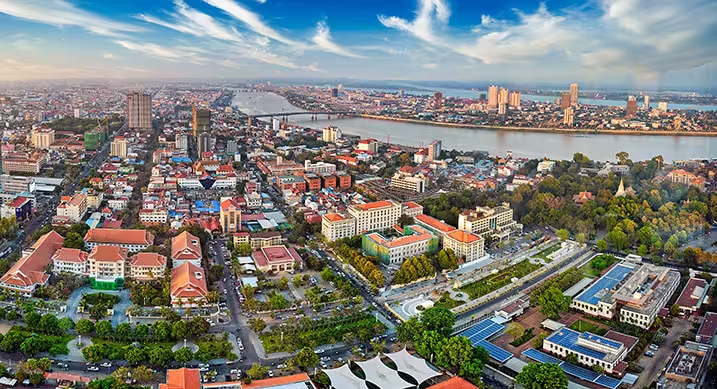Sights of Cambodia
A beautiful kingdom in southeast Asia, Cambodia is open to lovers of beautiful nature. Warm climate, soft beaches and friendly locals are happy to see tourists. In addition to all these beauties, Cambodia has many historical and religious monuments. The country has recently become a tourist destination, as the territory used to be the site of civil wars.
The capital of Cambodia is Phnom Penh, only recently the city has become a huge metropolis. On its territory there are luxurious 5-star hotels, large shopping centers. A chic market opens its doors in the central square, where you can buy silk products, souvenirs, local products and all kinds of goods produced in the country.
The Cambodian capital has grown into a thriving city and a significant tourist destination, from immersing yourself in Khmer culture to exploring the city’s heritage.
Royal Palace and Silver Pagoda
- The Royal Palace, with its classic Khmer roofs, dominates the skyline. Since the 1860s, the Royal Palace has been home to the royal family. The complex consists of four main structures: the Silver Pagoda, the Khemarin Palace, the Throne Hall and the Courtyard. Although half of the complex is closed to the public (because it is considered the residence of the king).

- One of the most expensive buildings in Cambodia is the Silver Pagoda. Its name comes from the fact that the floor of the temple is completely lined with silver ingots. The pagoda was erected at the end of the 19th century by order of King Norodom. In the very center of the hall is an emerald Buddha statue, and smaller copies of it surround it. The largest statue of this god reaches 90 kg and is decorated with crystals.
The Silver Pagoda and the Throne Hall are popular attractions that visitors are free to explore.
National Museum of Cambodia
- The largest architectural and historical museum presenting the cultural history of Cambodia is the National Museums of Cambodia. Even before entering the museums, visitors are greeted by luscious green gardens and a vibrant terracotta pavilion that stretches over four wings filled with an array of artefacts, including Khmer art and important Buddhist and Hindu government exhibits.
Phsar Thmei (Central Market)
- Phnom Penh’s Central Market was once considered the largest market in Asia and is an ideal place for shoppers looking to make a bargain. Built in 1937, the market has something for everyone -from old CDs and DVDs to T-shirts, batik and textiles, gold and precious stones.
City tour by bike
- Travel around the city the way the locals do -on the seat cycle rickshaws! These iconic vehicles arrived in Cambodia in 1936 and remain one of the best and most economical ways to see city. You can go on a tour of Phnom Penh where cycle rickshaw drivers will guide you through the busiest streets and to the main attractions.
Tuol Sleng Genocide Museum and Choeng Ek Genocide Center
- Although not a “pleasant” experience, understanding the history of Cambodia is an important part of visiting the country. Tuol Sleng was once a secondary school, but in 1975 the Khmer Rouge turned it into a prison. During Tuol Sleng’s four years of operation, more than 17,000 people were held in the prison. After the prison was disbanded by the Vietnamese army in 1979, Tuol Sleng was turned into history museums that commemorate the deeds of the regime. Choeng Ek (better known as the Killing Fields) was used as a mass grave site by the Khmer Rouge regime between 1975 and 1979. Now this place is a Buddhist stupa, created in memory of the victims of the regime.
Angkor Wat is a complex of temples built in the 12th century and is under the auspices of UNESCO. The structure expresses the empire of the Khmers, a local people, and they consider the complex to be their pride. The temples worship the main god Vishnu. The entire territory is surrounded by a filled moat, and there are only two entrances to the complex. Angkor Wat is rightfully the largest complex of temples in the world, its area is 2.5 km2.
Another UNESCO heritage is Prefkhvihea. For a long time, Thailand and Cambodia shared this complex of temples. In 2008, everything was resolved with the help of UNESCO. Buildings began to be built at the end of the 9th century and dedicated to Shiva. Prefhvihea has a staircase of almost 80m that leads to the base, many palaces and statues. The complex stands on 4 levels, depending on the increase in the hill.
Previously, the kingdom of Cambodia was under the influence of France. After the liberation, the Independence Monument was erected in the center of the capital. The architect of the building was the local architect V. Molivann. For any holiday, local authorities decorate the 20 meter tower with ribbons and flowers that mimic the national flag.
The best place for quiet and peaceful walks is the Sisowat promenade, on the banks of the Tonle Sap. Fresh air can whet the appetite of tourists, so the entire promenade is accompanied by small restaurants that are located in 19th-century houses. The main holidays of the country are held here. Local authorities and residents do not spare money and effort for colorful performances.
Beach lovers will certainly go to the resort of Sihanoukville. Here you can find hotels for any budget, from hostels to 5stars. On the shores you can find many cafes and bars that offer a variety of cuisine from all over the world. The resort is still developing to make tourists more comfortable in various aspects. By boat you can visit the nearest islands, where there are wild beaches.

Contact our company representative
Elena Mislitchi
or write to the messenger:
